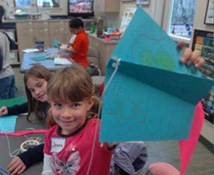
Space, the last frontier, is as near as Smyrna
Foundation's outpost offers programs designed to inspire children to study the science of Earth and the universe.
By EDWARD L. KENNEY • The News Journal • April 19, 2009
Like many Delaware schoolchildren on spring break this week, 10-year-old Jonathan Waters did not have to go to school -- but he kept his learning alive during a science day camp at the Delaware AeroSpace Education Foundation's Environmental Outpost in Smyrna.
And missing some vacation did not bother him a bit, especially after he got to conduct a kite-flying experiment with an indoor fan.
"I like learning on spring break because it gets me caught up on what we're learning at school," said Jonathan, a fourth-grader at the Campus Community Charter School in Dover.
Lynda Rae Gannon, a retired teacher in the Lake Forest School District who teaches part time at the site, is encouraged by that kind of attitude.
"I think we provide fun, engaging activities for them to do that have a lesson," she said.
 Lynda Rae Gannon helps students build kites at a recent day camp at the Delaware AeroSpace Education Foundation's outpost in Smyrna. After building the kites, the students tested them using indoor fans. |
 Jenna Harmon, 6, proudly displays the kite she made. Behind her is Jessie Eastburn, 10. The foundation's mission is to inspire children to study thesciences. A new building will include a dormitory so children can participate in overnight programs. |
"And we make them think, we challenge them." The special science camp was designed specifically for children on spring break, and 13 children ages 6 to 10 spent much of the day learning about flight. But the outpost normally buzzes with children -- and even some adults -- several times each week. The science themes change, as do the ages of the children. What remains the same is the foundation's goal.
"Our mission is to provide as many exceptional experiences as we can for students and teachers so they can appreciate as much as they can about the Earth and its place in the universe," foundation president Stephanie Wright said.
Wright, a former teacher, started the foundation almost 20 years ago, shortly after becoming involved in the Teacher in Space program. Inspired by photos of Earth from space, she started with science-outreach activities before she had a building. The outpost opened in April 2006, and field trips to the facility started cranking up by that December. More than 10,000 people have visited the site to learn about science, technology, engineering and math.
Children who look out the outpost's window can see the steel girders forming a skeleton that will one day grow to become another foundation building. The third floor of the building will become a dormitory, allowing children to visit for overnight programs. The 43,000-square-foot structure also will house a hands-on museum, classrooms and educational displays. The foundation is tackling the project a stage at a time as money becomes available, Wright said. Construction of an exterior covering for those girders should begin in late spring.
The Wilmer project wasunderwritten by TD Bank in an effort to bring attention to this incredible marine mammal.
Naturally, the new building will feature a host of environmentally "green" components, Wright said. On Wednesday, workers also installed solar panels on the outpost, replacing the olds ones and providing enough juice to allow the foundation to sell some energy back to the electric company.
Walls of the main room in the Environmental Outpost are ringed with cubbyholes that hold containers filled with science supplies and labeled with words such as "Dinosaurs," "Minerals," "Birds" and "Space Exploration." An astronomical observatory adjoining this room houses a 16-inch telescope, one of the largest in the state. Family nights give visitors a chance to peer out at the cosmos and learn about the planets and stars.
"This is a great learning center," said Tom Pribanic, who serves on the foundation's board. "I can't say enough about it. It's just so good to see the happy looks on the kids' faces when they come here. The whole thing is to get them inspired to study the sciences."
Although most of the program participants from all three Delaware counties are in preschool through middle school, participants also have included college students and even a group of senior residents of an assisted-living facility, Gannon said. Scouts and birthday-party groups also visit. The program fees range from about $5 to $15.
David Stevenson, 9, a third-grader at Stokes Elementary in Dover, likes coming to the programs so much that he has visited "at least four times."
"I like that we get to look in the telescope and look at all the different things," he said. "It's really cool."
For science's sake, Wright likes to hear that.
"If you can impress them at an early age, there is hope that they might go into this field and keep the United States in an economically stable position and maintain our leadership role in the world," she said.
Delaware AeroSpace Education Foundation's programs
To find out more about the Delaware AeroSpace Education Foundation's programs, visit the dasef.org Web site or call
(302)834-1978. The organization will hold a Family Day fundraiser for its educational programs from noon to 4 p.m. Saturday at the Environmental Outpost in Big Oak Park in Smyrna. The entrance fee is $5 per person (free for children ages 3 and younger) and includes refreshments, rocket-launching and kite-flying demonstrations, an outdoor maze, games, tents and a flight simulator. The fundraising event, held twice a year, typically draws almost 1,000 people. The park is at 585 Big Oak Road, off U.S. 13.